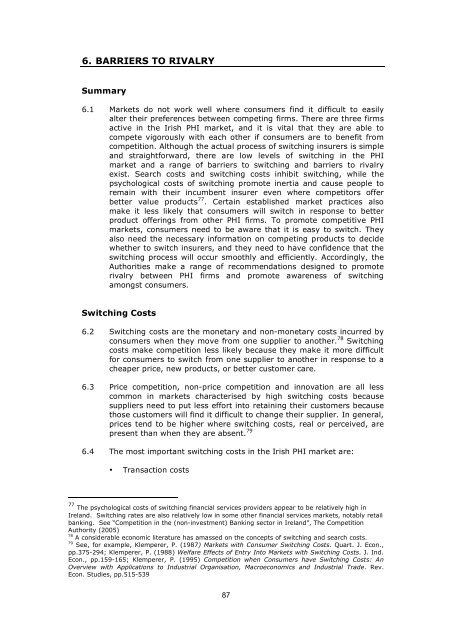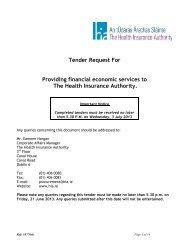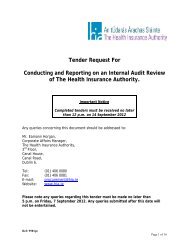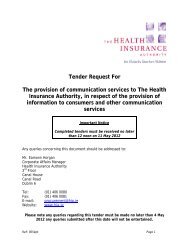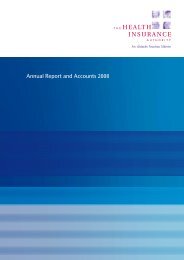Competition in the Irish Private Health Insurance Market
Competition in the Irish Private Health Insurance Market
Competition in the Irish Private Health Insurance Market
You also want an ePaper? Increase the reach of your titles
YUMPU automatically turns print PDFs into web optimized ePapers that Google loves.
6. BARRIERS TO RIVALRY<br />
Summary<br />
6.1 <strong>Market</strong>s do not work well where consumers f<strong>in</strong>d it difficult to easily<br />
alter <strong>the</strong>ir preferences between compet<strong>in</strong>g firms. There are three firms<br />
active <strong>in</strong> <strong>the</strong> <strong>Irish</strong> PHI market, and it is vital that <strong>the</strong>y are able to<br />
compete vigorously with each o<strong>the</strong>r if consumers are to benefit from<br />
competition. Although <strong>the</strong> actual process of switch<strong>in</strong>g <strong>in</strong>surers is simple<br />
and straightforward, <strong>the</strong>re are low levels of switch<strong>in</strong>g <strong>in</strong> <strong>the</strong> PHI<br />
market and a range of barriers to switch<strong>in</strong>g and barriers to rivalry<br />
exist. Search costs and switch<strong>in</strong>g costs <strong>in</strong>hibit switch<strong>in</strong>g, while <strong>the</strong><br />
psychological costs of switch<strong>in</strong>g promote <strong>in</strong>ertia and cause people to<br />
rema<strong>in</strong> with <strong>the</strong>ir <strong>in</strong>cumbent <strong>in</strong>surer even where competitors offer<br />
better value products 77 . Certa<strong>in</strong> established market practices also<br />
make it less likely that consumers will switch <strong>in</strong> response to better<br />
product offer<strong>in</strong>gs from o<strong>the</strong>r PHI firms. To promote competitive PHI<br />
markets, consumers need to be aware that it is easy to switch. They<br />
also need <strong>the</strong> necessary <strong>in</strong>formation on compet<strong>in</strong>g products to decide<br />
whe<strong>the</strong>r to switch <strong>in</strong>surers, and <strong>the</strong>y need to have confidence that <strong>the</strong><br />
switch<strong>in</strong>g process will occur smoothly and efficiently. Accord<strong>in</strong>gly, <strong>the</strong><br />
Authorities make a range of recommendations designed to promote<br />
rivalry between PHI firms and promote awareness of switch<strong>in</strong>g<br />
amongst consumers.<br />
Switch<strong>in</strong>g Costs<br />
6.2 Switch<strong>in</strong>g costs are <strong>the</strong> monetary and non-monetary costs <strong>in</strong>curred by<br />
consumers when <strong>the</strong>y move from one supplier to ano<strong>the</strong>r. 78 Switch<strong>in</strong>g<br />
costs make competition less likely because <strong>the</strong>y make it more difficult<br />
for consumers to switch from one supplier to ano<strong>the</strong>r <strong>in</strong> response to a<br />
cheaper price, new products, or better customer care.<br />
6.3 Price competition, non-price competition and <strong>in</strong>novation are all less<br />
common <strong>in</strong> markets characterised by high switch<strong>in</strong>g costs because<br />
suppliers need to put less effort <strong>in</strong>to reta<strong>in</strong><strong>in</strong>g <strong>the</strong>ir customers because<br />
those customers will f<strong>in</strong>d it difficult to change <strong>the</strong>ir supplier. In general,<br />
prices tend to be higher where switch<strong>in</strong>g costs, real or perceived, are<br />
present than when <strong>the</strong>y are absent. 79<br />
6.4 The most important switch<strong>in</strong>g costs <strong>in</strong> <strong>the</strong> <strong>Irish</strong> PHI market are:<br />
• Transaction costs<br />
77 The psychological costs of switch<strong>in</strong>g f<strong>in</strong>ancial services providers appear to be relatively high <strong>in</strong><br />
Ireland. Switch<strong>in</strong>g rates are also relatively low <strong>in</strong> some o<strong>the</strong>r f<strong>in</strong>ancial services markets, notably retail<br />
bank<strong>in</strong>g. See “<strong>Competition</strong> <strong>in</strong> <strong>the</strong> (non-<strong>in</strong>vestment) Bank<strong>in</strong>g sector <strong>in</strong> Ireland”, The <strong>Competition</strong><br />
Authority (2005)<br />
78 A considerable economic literature has amassed on <strong>the</strong> concepts of switch<strong>in</strong>g and search costs.<br />
79 See, for example, Klemperer, P. (1987) <strong>Market</strong>s with Consumer Switch<strong>in</strong>g Costs. Quart. J. Econ.,<br />
pp.375-294; Klemperer, P. (1988) Welfare Effects of Entry Into <strong>Market</strong>s with Switch<strong>in</strong>g Costs. J. Ind.<br />
Econ., pp.159-165; Klemperer, P. (1995) <strong>Competition</strong> when Consumers have Switch<strong>in</strong>g Costs: An<br />
Overview with Applications to Industrial Organisation, Macroeconomics and Industrial Trade. Rev.<br />
Econ. Studies, pp.515-539<br />
87


